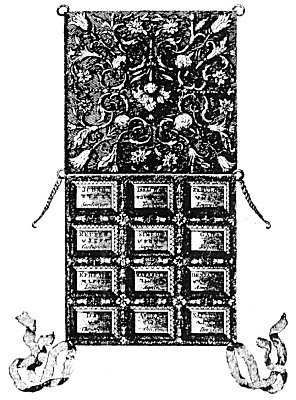Josephus hints that there was a third compartment which was formed by subdividing the Holy Place, at least hypothetically, into two chambers. The Jewish historian is not very explicit in his description of this third room, and the majority of writers seem to have entirely overlooked and neglected this point, although Josephus emphatically states that Moses himself divided the inner tent into three sections. The veil separating the Holy Place from the Holy of Holies was hung across four pillars, which probably indicated in a subtle way the four elements, while at the entrance to the tent proper the Jews placed seven pillars, referring to the seven senses and the seven vowels of the Sacred Name. That later only five pillars are mentioned may be accounted for by the fact that at the present time man has only five developed senses and five active vowels. The early Jewish writer of The Baraitha treats of the curtains as follows:
“There were provided ten curtains of blue, of purple, and scarlet, and fine-twined linen. As is said, ‘Moreover thou shall make the tabernacle with ten curtains of fine-twined linen, and blue, and purple, and scarlet.’ * * * There were provided eleven curtains of goats’ hair, and the length of every one of them was thirty cubits, * * *. Rabbi Judah said, ‘There were two covers-the lower one of rams’ skins dyed red, and the upper one of badgers’ skins. ‘”
Calmet is of the opinion that the Hebrew word translated “badger” really means “dark purple” and therefore did not refer to any particular animal, but probably to a heavily woven waterproof fabric of dark and inconspicuous color. During the time of Israel’s wanderings through the wilderness, it is supposed that a pillar of fire hovered over the Tabernacle at night, while a column of smoke traveled with it by day. This cloud was called by the Jews the Shechinah and was symbolic of the presence of the Lord. In one of the early Jewish books rejected at the time of the compiling of the Talmud the following description of the Shechinah appears:
“Then a cloud covered the tent of the congregation, and the glory of the Lord filled the Tabernacle. And that was one of the clouds of glory, which served the Israelites in the wilderness forty years. One on the right hand, and one on the left, and one before them, and one behind them. And one over them, and a cloud dwelling in their midst (and the cloud, the Shechinah which was in the tent), and the pillar of cloud which moved before them, making low before them the high places, and making high before them the low places, and killing serpents and scorpions, and burning thorns and briars, and guiding them in the straight way.” (From The Baraitha, the Book of the Tabernacle.)
THE FURNISHINGS OF THE TABERNACLE
There is no doubt that the Tabernacle, its furnishings and ceremonials, when considered esoterically, are analogous to the structure, organs, and functions of the human body. At the entrance to the outer court of the Tabernacle stood the Altar of Burnt Offerings, five cubits long and five cubits wide but only three cubits high. Its upper surface was a brazen grill upon which the sacrifice was placed, while beneath was a space for the fire. This altar signified
THE BREASTPLATE OF THE HIGH PRIEST.
From Calmet’s Dictionary of the Holy Bible. The order of the stones and the tribe over which each administered were, according to Calmet, as in the above diagram. These gems, according to the Rosicrucians, were symbolic of the twelve great qualities and virtues: Illumination, Love, Wisdom, Truth, Justice, Peace, Equilibrium, Humility, Faith, Strength, Joy, Victory.
p. 135
that a candidate, when first entering the precincts of sanctuary, must offer upon the brazen altar not a poor unoffending bull or ram but its correspondence within his own nature. The bull, being symbolic of earthiness, represented his own gross constitution which must be burned up by the fire of his Divinity. (The sacrificing of beasts, and in some cases human beings, upon the altars of the pagans was the result of their ignorance concerning the fundamental principle underlying sacrifice. They did not realize that their offerings must come from within their own natures in order to be acceptable.)

Moe is the founder of GnosticWarrior.com. He is a father, husband, author, martial arts black belt, and an expert in Gnosticism, the occult, and esotericism.





